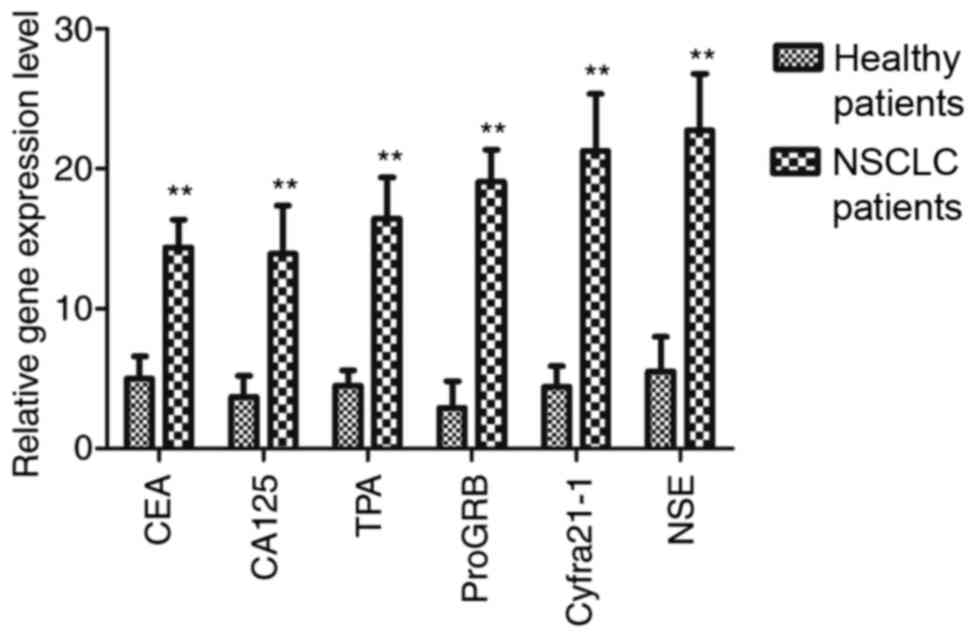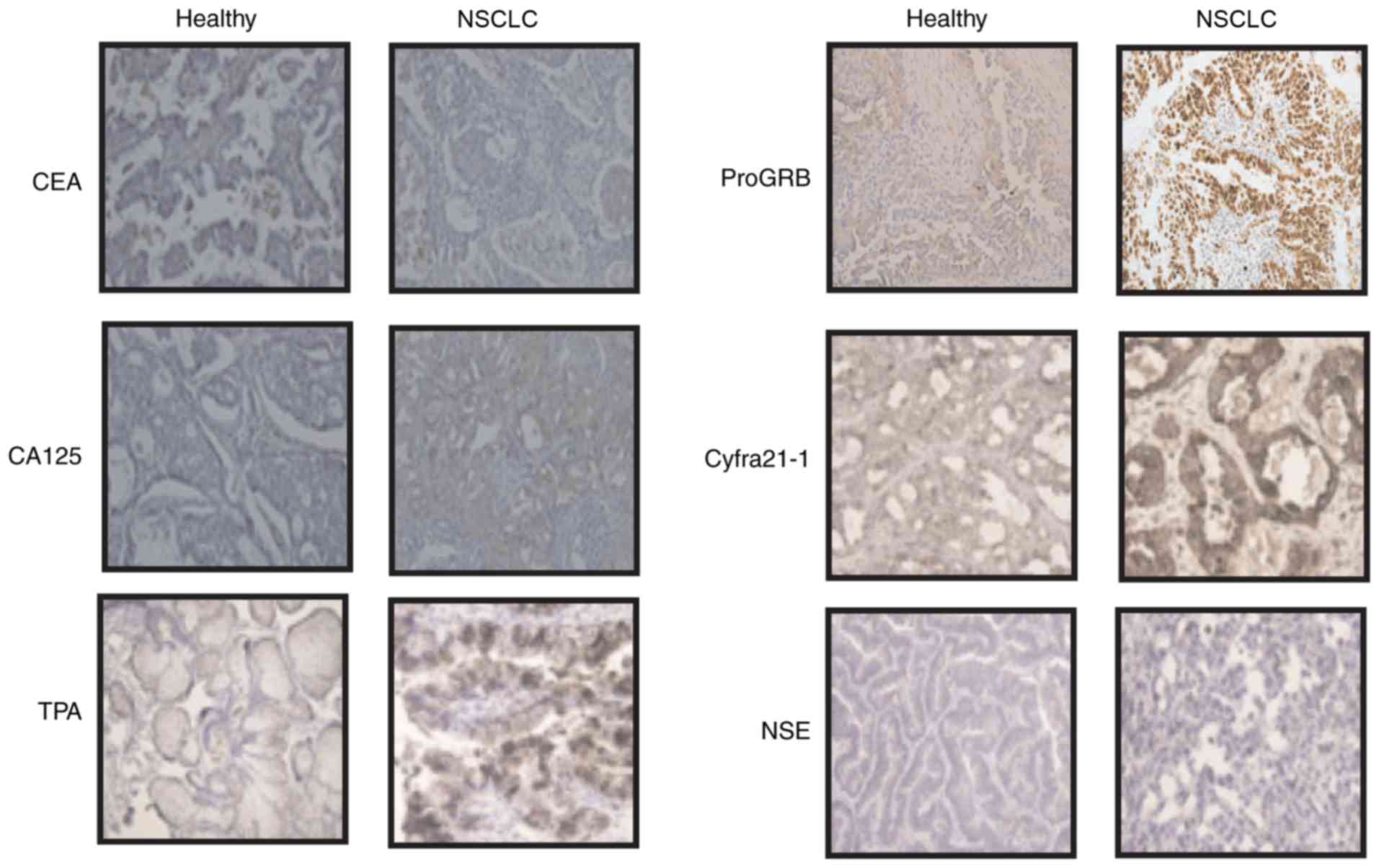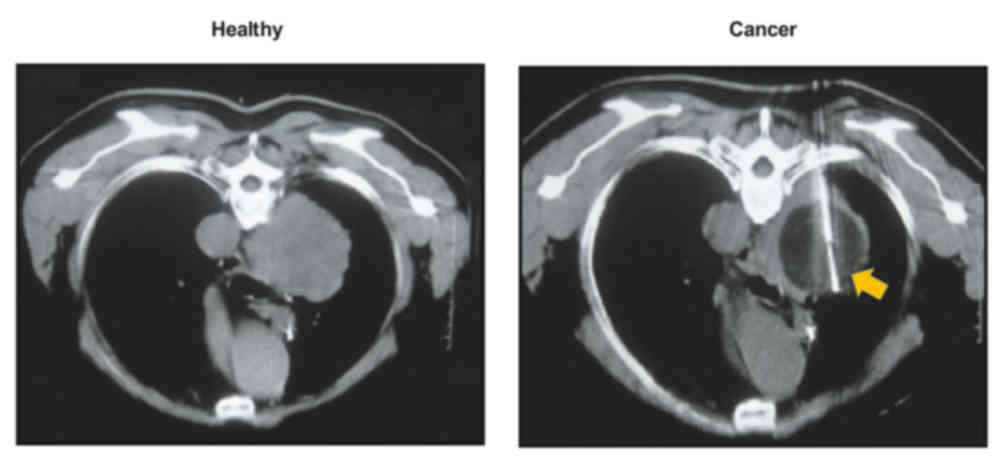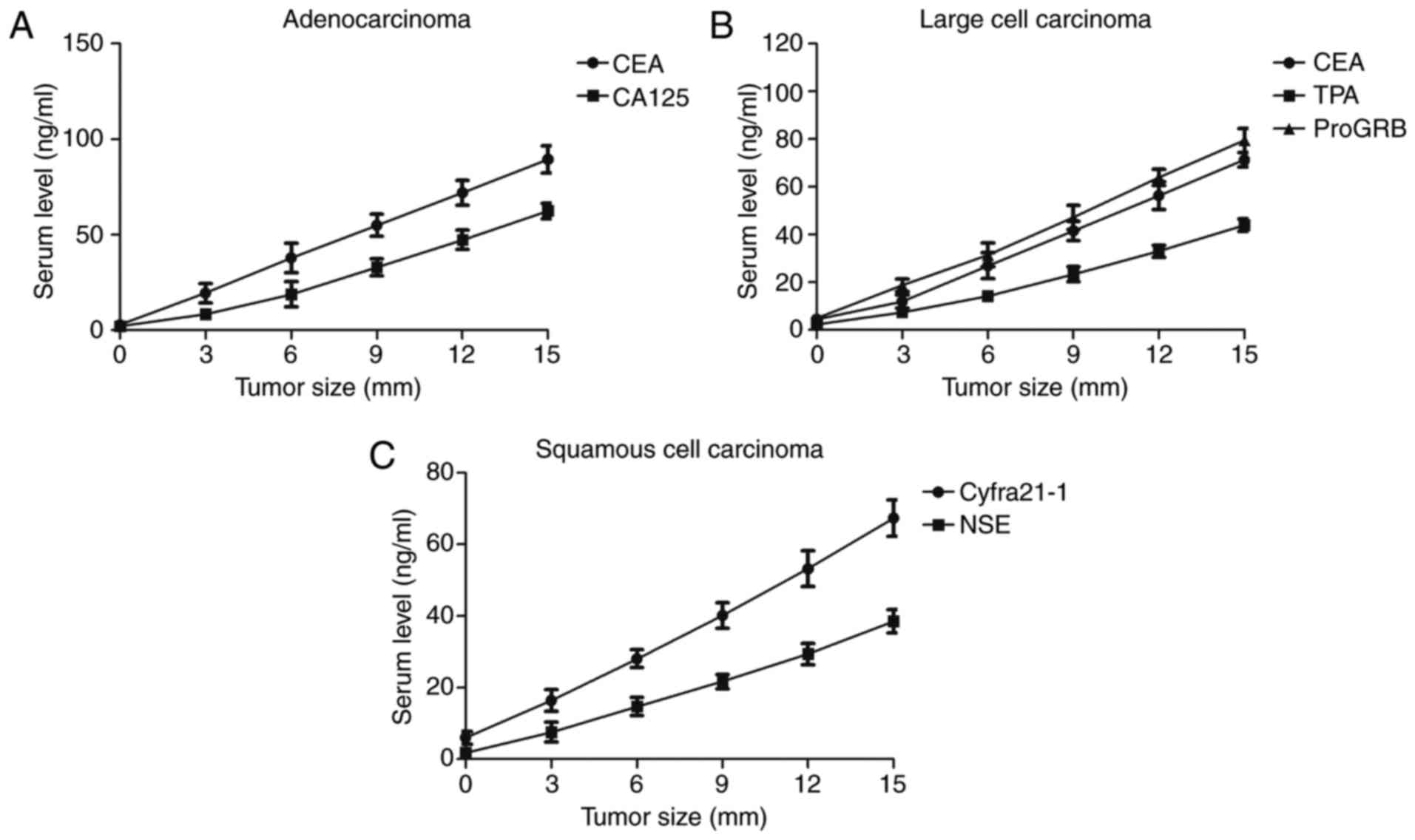|
1
|
Paleiron N, Bylicki O, André M, Rivière E,
Grassin F, Robinet G and Chouaïd C: Targeted therapy for localized
non-small-cell lung cancer: A review. Onco Targets Ther.
9:4099–4104. 2016. View Article : Google Scholar : PubMed/NCBI
|
|
2
|
Li SJ, Huang J, Zhou XD, Zhang WB, Lai YT
and Che GW: Clinicopathological and prognostic significance of
Oct-4 expression in patients with non-small cell lung cancer: A
systematic review and meta-analysis. J Thorac Dis. 8:1587–1600.
2016. View Article : Google Scholar : PubMed/NCBI
|
|
3
|
Aokage K, Yoshida J, Hishida T, Tsuboi M,
Saji H, Okada M, Suzuki K, Watanabe S and Asamura H: Limited
resection for early-stage non-small cell lung cancer as
function-preserving radical surgery: A review. Jpn J Clin Oncol.
47:7–11. 2017. View Article : Google Scholar : PubMed/NCBI
|
|
4
|
Brody H: Lung cancer. Nature. 513:S12014.
View Article : Google Scholar : PubMed/NCBI
|
|
5
|
Moro-Sibilot D, Smit E, de Castro Carpeño
J, Lesniewski-Kmak K, Aerts JG, Villatoro R, Kraaij K, Nacerddine
K, Dyachkova Y, Smith KT, et al: Non-small cell lung cancer
patients with brain metastases treated with first-line
platinum-doublet chemotherapy: Analysis from the European FRAME
study. Lung Cancer. 90:427–432. 2015. View Article : Google Scholar : PubMed/NCBI
|
|
6
|
Barnett SA, Downey RJ, Zheng J, Plourde G,
Shen R, Chaft J, Akhurst T, Park BJ and Rusch VW: Utility of
routine PET imaging to predict response and survival after
induction therapy for non-small cell lung cancer. Ann Thorac Surg.
101:1052–1059. 2016. View Article : Google Scholar : PubMed/NCBI
|
|
7
|
Loganadane G, Martinetti F, Mercier O,
Krhili S, Riet FG, Mbagui R, To H, Le Péchoux C and Levy A:
Stereotactic ablative radiotherapy for early stage non-small cell
lung cancer: A critical literature review of predictive factors of
relapse. Cancer Treat Rev. 50:240–246. 2016. View Article : Google Scholar : PubMed/NCBI
|
|
8
|
Kim JO, Davis F, Butts C and Winget M:
Waiting time intervals for non-small cell lung cancer diagnosis and
treatment in alberta: Quantification of intervals and
identification of risk factors associated with delays. Clin Oncol
(R Coll Radiol). 28:750–759. 2016. View Article : Google Scholar : PubMed/NCBI
|
|
9
|
Zheng D and Chen H: Advances in liquid
biopsy and its clinical application in the diagnosis and treatment
of non-small cell lung cancer. Zhongguo Fei Ai Za Zhi. 19:394–398.
2016.(In Chinese). PubMed/NCBI
|
|
10
|
Benitez-Majano S, Fowler H, Maringe C, Di
Girolamo C and Rachet B: Deriving stage at diagnosis from multiple
population-based sources: Colorectal and lung cancer in England. Br
J Cancer. 115:391–400. 2016. View Article : Google Scholar : PubMed/NCBI
|
|
11
|
Sheu CC, Chang MY, Chang HC, Tsai JR, Lin
SR, Chang SJ, Hwang JJ, Huang MS and Chong IW: Combined detection
of CEA, CK-19 and c-met mRNAs in peripheral blood: A highly
sensitive panel for potential molecular diagnosis of non-small cell
lung cancer. Oncology. 70:203–211. 2006. View Article : Google Scholar : PubMed/NCBI
|
|
12
|
Chanvorachote P, Luanpitpong S, Chunhacha
P, Promden W and Sriuranpong V: Expression of CA125 and cisplatin
susceptibility of pleural effusion-derived human lung cancer cells
from a Thai patient. Oncol Lett. 4:252–256. 2012. View Article : Google Scholar : PubMed/NCBI
|
|
13
|
Passowicz-Muszyńska E, Gisterek I,
Marciniak M, Kornafel J, Kolodziej J and Jankowska R: Tumor markers
TPA and Cyfra 21.1 in patients with non-small cell lung cancer
after surgery and chemotherapy. Pol Merkur Lekarski. 13:294–297.
2002.(In Polish). PubMed/NCBI
|
|
14
|
Tang JH, Zhang XL, Zhang ZH, Wang R, Zhang
HM, Zhang ZL, Wang JH and Ren WD: Diagnostic value of tumor marker
pro-gastrin-releasing peptide in patients with small cell lung
cancer: A systematic review. Chin Med J (Engl). 124:1563–1568.
2011.PubMed/NCBI
|
|
15
|
Lazarev SM, Massard ZH, Reshetov AV,
Nikolaev GV, Volgin GN, Osipov EV, Lomteva EIu, Nokhrin AV and
Kakysheva OE: Role of biological tumor markers CEA, Cyfra-21, NSE,
TU M2-PK in diagnosis and treatment of lung cancer. Vestn Khir Im I
I Grek. 169:39–43. 2010.(In Russian). PubMed/NCBI
|
|
16
|
Raz DJ, Wu GX, Consunji M, Nelson RA, Kim
H, Sun CL, Sun V and Kim JY: The effect of primary care physician
knowledge of lung cancer screening guidelines on perceptions and
utilization of low-dose computed tomography. Clin Lung Cancer.
19:51–57. 2018. View Article : Google Scholar : PubMed/NCBI
|
|
17
|
Kawakami W, Takemura A, Yokoyama K,
Nakajima K, Yokoyama S and Koshida K: The use of positron emission
tomography/computed tomography imaging in radiation therapy: A
phantom study for setting internal target volume of biological
target volume. Radiat Oncol. 10:12015. View Article : Google Scholar : PubMed/NCBI
|
|
18
|
Edge SB and Compton CC: The American joint
committee on cancer: The 7th edition of the AJCC cancer staging
manual and the future of TNM. Ann Surg Oncol. 17:1471–1474. 2010.
View Article : Google Scholar : PubMed/NCBI
|
|
19
|
Livak KJ and Schmittgen TD: Analysis of
relative gene expression data using real-time quantitative PCR and
the 2(-Delta Delta C(T)) method. Methods. 25:402–408. 2001.
View Article : Google Scholar : PubMed/NCBI
|
|
20
|
Hayes AF and Rockwood NJ: Regression-based
statistical mediation and moderation analysis in clinical research:
Observations, recommendations, and implementation. Behav Res Ther.
98:39–57. 2017. View Article : Google Scholar : PubMed/NCBI
|
|
21
|
Fenton-Ambrose L and Kazerooni EA:
Preventative care: Lung-cancer screens now worth the cost. Nature.
514:352014. View
Article : Google Scholar : PubMed/NCBI
|
|
22
|
Herth F, Kirsch CM and Stoelben E:
Diagnosis of non-small-cell lung carcinoma (NSCLC). Onkologie.
29(Suppl 2): S3–S6. 2006.(In German). View Article : Google Scholar
|
|
23
|
Fiala O, Pesek M, Finek J, Svaton M,
Sorejs O, Bortlicek Z, Kucera R and Topolcan O: Prognostic
significance of serum tumor markers in patients with advanced-stage
NSCLC treated with pemetrexed-based chemotherapy. Anticancer Res.
36:461–466. 2016.PubMed/NCBI
|
|
24
|
Barrio-Muñoz M1, Abad-Gairín C,
Amengual-Guedán JM and Prats-López J: Diagnosis of prostate cancer
by analyzing oxidative stress in human seminal plasma: Developing
unsophisticated tools for noninvasive prostate cancer diagnosis.
Eur J Cancer Prev. 25:518–523. 2016. View Article : Google Scholar : PubMed/NCBI
|
|
25
|
Yang L, Wang J, Li J, Zhang H, Guo S, Yan
M, Zhu Z, Lan B, Ding Y, Xu M, et al: Identification of serum
biomarkers for gastric cancer diagnosis using a human proteome
microarray. Mol Cell Proteomics. 15:614–623. 2016. View Article : Google Scholar : PubMed/NCBI
|
|
26
|
Zhu Y, Guo M, Zhang L, Xu T, Wang L and Xu
G: Biomarker triplet NAMPT/VEGF/HER2 as a de novo detection panel
for the diagnosis and prognosis of human breast cancer. Oncol Rep.
35:454–462. 2016. View Article : Google Scholar : PubMed/NCBI
|
|
27
|
Li S, Zheng Q, Ma Y, Wang Y, Feng Y, Zhao
B and Yang Y: Implications of false negative and false positive
diagnosis in lymph node staging of NSCLC by means of
¹8F-FDG PET/CT. PLoS One. 8:e785522013. View Article : Google Scholar : PubMed/NCBI
|
|
28
|
Kim HS, Lee KS, Ohno Y, van Beek EJ and
Biederer J: PET/CT versus MRI for diagnosis, staging, and follow-up
of lung cancer. J Magn Reson Imaging. 42:247–260. 2015. View Article : Google Scholar : PubMed/NCBI
|
|
29
|
Takahashi Y, Takashima S, Hakucho T,
Miyake C, Morimoto D, Jiang BH, Numasaki H, Tomita Y, Nakanishi K
and Higashiyama M: Diagnosis of regional node metastases in lung
cancer with computer-aided 3D measurement of the volume and
CT-attenuation values of lymph nodes. Acad Radiol. 20:740–745.
2013. View Article : Google Scholar : PubMed/NCBI
|
|
30
|
Yang YJ, Cheng DY, Fang X and Li XX: The
clinical diagnosis value of fibro-optic bronchoscope examination
combined with tumor marker determination to lung cancer. Sichuan Da
Xue Xue Bao Yi Xue Ban. 38:312–315. 2007.(In Chinese). PubMed/NCBI
|
|
31
|
Shi GL, Hu XL, Yue SD and Song CX: The
value of serum tumor marker in the diagnosis of lung cancer.
Zhonghua Zhong Liu Za Zhi. 27:299–301. 2005.PubMed/NCBI
|
|
32
|
Pollán M, Varela G, Torres A, de la Torre
M, Ludeña MD, Ortega MD, Pac J, Freixenet J, Gómez G, Sebastián F,
et al: Clinical value of p53, c-erbB-2, CEA and CA125 regarding
relapse, metastasis and death in resectable non-small cell lung
cancer. Int J Cancer. 107:781–790. 2003. View Article : Google Scholar : PubMed/NCBI
|
|
33
|
Wang P, Piao Y, Zhang X, Li W and Hao X:
The concentration of CYFRA 21-1, NSE and CEA in cerebro-spinal
fluid can be useful indicators for diagnosis of meningeal
carcinomatosis of lung cancer. Cancer Biomark. 13:123–130. 2013.
View Article : Google Scholar : PubMed/NCBI
|
|
34
|
Wang H and Qian J: Serum
pro-gastrin-releasing peptide in diagnosis of small cell lung
cancer: A meta-analysis. J Cancer Res Ther. 12 Suppl:C260–C263.
2016. View Article : Google Scholar : PubMed/NCBI
|


















